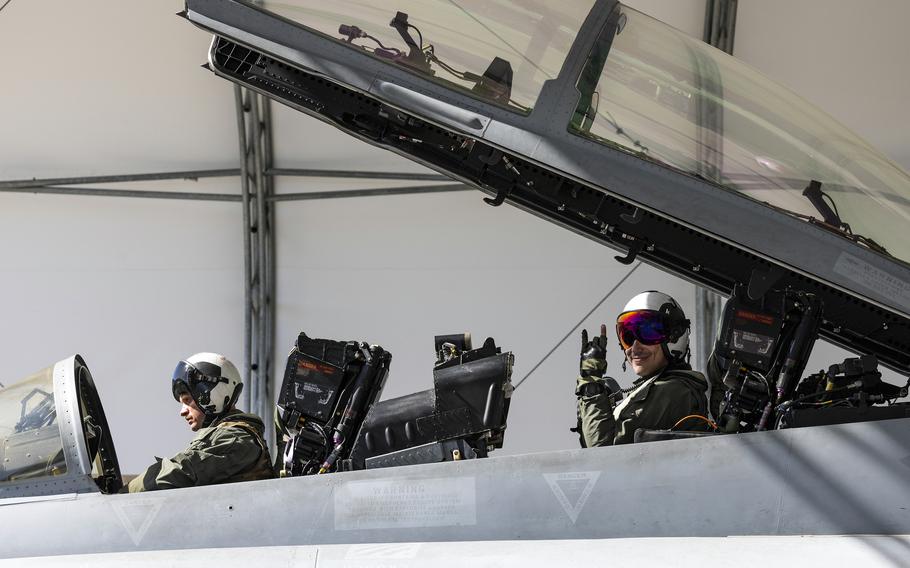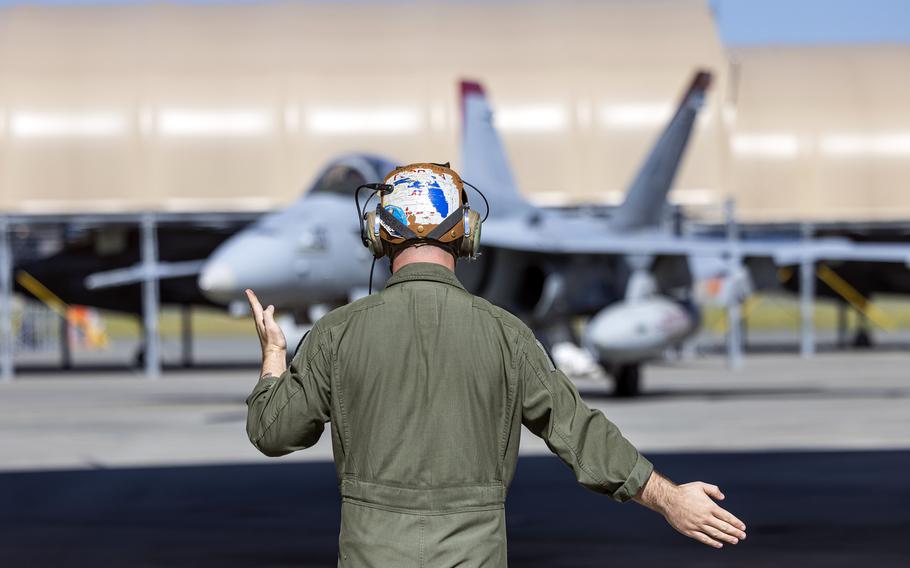
Members of Marine Fighter Attack Squadron 232 prepare to disembark an F/A-18D after landing at Marine Corps Air Station Iwakuni, Japan, Sept. 24, 2023. (Bryant Rodriguez/U.S. Marine Corps)
MARINE CORPS AIR STATION IWAKUNI, Japan — The first contingent of Marine “legacy” fighters from California rolled to a stop at this base south of Hiroshima late last month with a dozen aircraft sporting newly upgraded radar.
The Red Devils of Marine Fighter Attack Squadron 232 from Marine Corps Air Station Miramar will operate their F/A-18C and F/A-18D Hornets from MCAS Iwakuni as part of a six-month unit deployment, squadron commander Lt. Col. Michael McMahon told Stars and Stripes by phone Wednesday.
“We’re the first F/A-18C squadron to get this new, active electronically scanned array radar, [it’s] very similar to what the Super Hornets have,” he said. “This radar has definitely increased our capabilities in all aspects of what we do.”
Raytheon’s APG-79(V)4 provides Hornet aircrews with improved situational awareness, better ability to track targets nearly instantaneously and improved capacity for tracking many targets, according to MilitaryAerospace.com in September 2022.
The improved radar is built with open system architecture and commercial-off-the-shelf parts that deliver an increased air-to-air and air-to-surface targeting and tracking capabilities, according to Raytheon’s website.
“It’s definitely an edge over the rest of the F/A-18, the legacy charlies and delta fleet that’s out there,” McMahon said.

Marine Corps Cpl. David Rarrick, a mechanic with Marine Fighter Attack Squadron 232, guides an F/A-18D at Marine Corps Air Station Iwakuni, Japan, Sept. 24, 2023. (Bryant Rodriguez/U.S. Marine Corps)
The radar upgrade is a “big deal” that will help keep the Hornets relevant toward the end of the decade as the Marine Corps looks at downsizing its aging aircraft, he said.
“Every single day, almost every sortie we went on, we were integrated with the F-35s,” he said, referring to the fifth-generation stealth fighter flown by the Marines, Navy and Air Force. “[The F/A-18] is a multi-role fighter; we do air-to-air, air-to-ground and anti-maritime.”
Pairing the Hornet with the F-35 complements each aircraft’s capabilities, McMahon said.
“The anti-maritime weapons and the number of strike weapons [and] the number of air weapons we can carry, in comparison to the F-35B, we can carry a little bit more,” he said. “We’re commonly called a ‘weapons truck’ for those folks.”
MCAS Iwakuni also has two squadrons of permanently assigned F-35Bs, the variant designed for short takeoffs and vertical landings.
“Flying with those guys, especially with the new radar, seeing, no kidding, when you get to debrief face-to-face and see their capabilities and what they bring to the fight and how you can complement them and how they can complement ours, it’s a great experience,” McMahon said.
This is the Red Devils’ seventh deployment to MCAS Iwakuni, he said.
“We came over to show the Japanese we are here to support,” he said. “It’s also just part of putting forces out here in the Pacific to train and create those relationships, not just with foreign partners but also it’s a good time for us to work with the Air Force.”